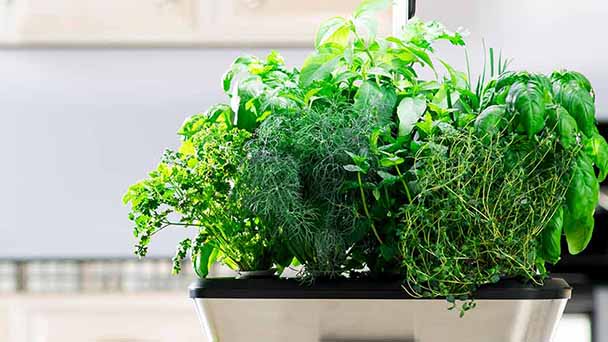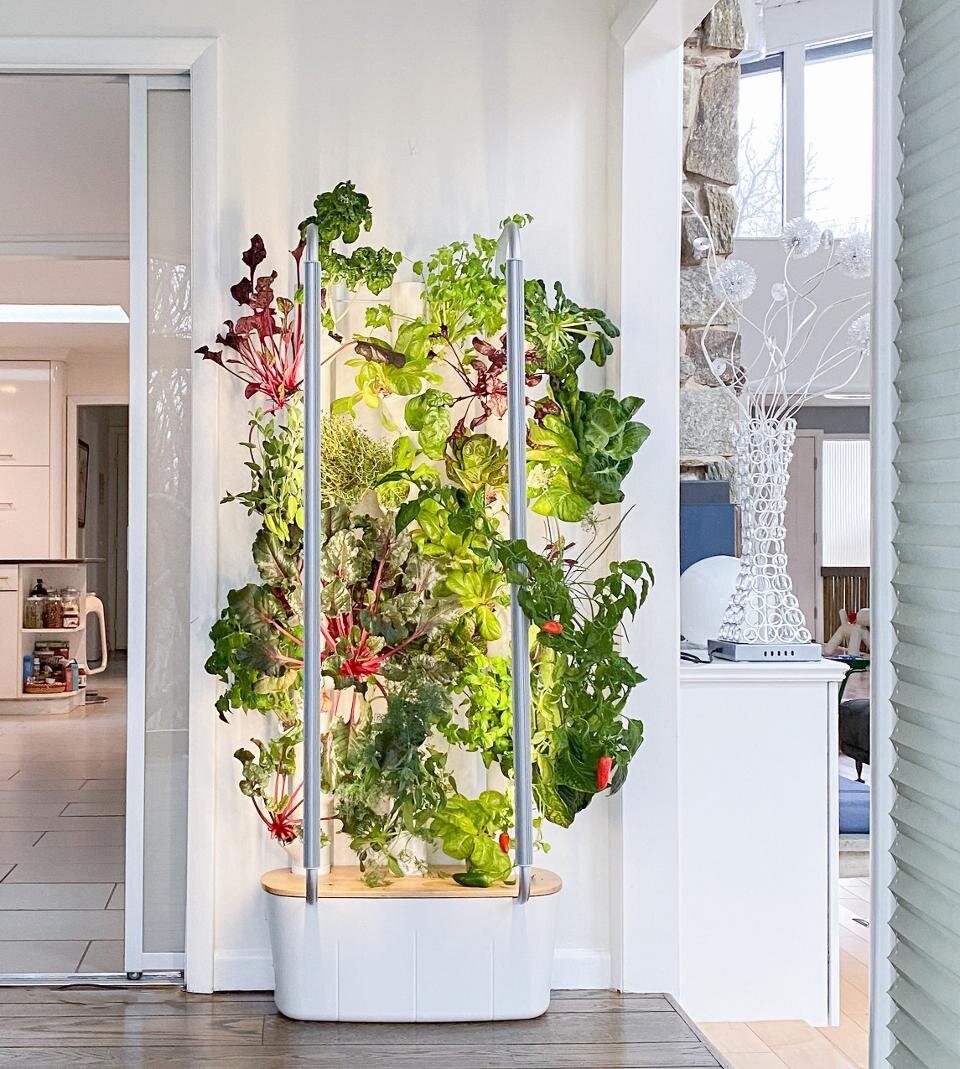Indoor hydroponic garden ideas
Written by Joy
Oct 22 2021

After discarding the soil, you can try indoor hydroponic garden plants without soil. There are two hydroponic gardening methods: directly immerse any root in nutrient-rich water, or grow plants in a container containing a soil-free mixture of perlite and sand. The container is then immersed or suspended above the water-filled container.
The flood and drainage system requires submersible pumps, but they are still fairly simple. Plant containers are placed in shallow trays or growth tubes are suspended on reservoirs filled with hydroponic nutrients. The tray is periodically filled with water from the reservoir, allowing the indoor hydroponic garden to soak nutrients through the drain holes in the bottom of the container. After a period of time, the water will be discharged back to the reservoir. This prevents root rot caused by excessive moisture. Typically, the system is flooded and drained two to four times a day.
In a hydroponic system, the roots of plants are continuously located in the nutrient-rich water in the hydroponic tank. The planting container hangs directly above the head, so the roots extend down into the water. A small bubbler, such as that used in a fish tank, aerates the water and prevents it from stagnating. This is one of the simplest DIY hydroponic planting systems, which are suitable for lettuce, herbs and other light crops.
You should add hydroponic nutrients to the reservoir according to your specific brand's instructions. There are many liquid and powder forms to choose from. You'd better fill the tank with filtered rather than tap water. Tap water usually contains fluoride and other elements that may harm plants.
The ideal water temperature for your hydroponic garden is 65 to 75 degrees Fahrenheit, and the pH is between 5.7 and 6.3. You should use a bubbler or pump to keep the water moving in the reservoir, such as the $51.41 Hydrofarm Submersible Water Pump from Amazon to prevent water accumulation and bacterial growth.
It's a good choice to empty, clean and refill your hydroponic nutrient solution reservoir every two weeks.
There are several different types of bulbs for hydroponic growth lamps, but for beginners with relatively small budgets, fluorescent tubes are a good choice. For a large garden, you need a full-length fluorescent lamp in the 6500K range, just like this fluorescent lamp on Amazon. However, for smaller gardens, or if your purpose is to save money, compact fluorescent bulbs provide a lot of light and are easy to use. You need to use plastic or metal growing light reflectors or shields to direct light to your hydroponic seedlings.
Types of indoor hydroponic garden systemsTake care of your indoor hydroponic gardenChoosing crops for indoor hydroponic gardeningUse Grow Lights
Types of indoor hydroponic garden systems
There are three basic types of hydroponic growth systems. The simplest indoor hydroponic garden is a wick system. In this very basic hydroponic water system, a wick connects the planting container and the reservoir to provide a stable and nutrient-rich water source for the plant's roots. This is a simple DIY system, but only suitable for miniature plants or small plants such as herbs.The flood and drainage system requires submersible pumps, but they are still fairly simple. Plant containers are placed in shallow trays or growth tubes are suspended on reservoirs filled with hydroponic nutrients. The tray is periodically filled with water from the reservoir, allowing the indoor hydroponic garden to soak nutrients through the drain holes in the bottom of the container. After a period of time, the water will be discharged back to the reservoir. This prevents root rot caused by excessive moisture. Typically, the system is flooded and drained two to four times a day.
In a hydroponic system, the roots of plants are continuously located in the nutrient-rich water in the hydroponic tank. The planting container hangs directly above the head, so the roots extend down into the water. A small bubbler, such as that used in a fish tank, aerates the water and prevents it from stagnating. This is one of the simplest DIY hydroponic planting systems, which are suitable for lettuce, herbs and other light crops.
Take care of your indoor hydroponic garden
Once you have set up a hydroponic kit or built your own indoor hydroponic garden, installed lights, and planted crops, basic maintenance is required.You should add hydroponic nutrients to the reservoir according to your specific brand's instructions. There are many liquid and powder forms to choose from. You'd better fill the tank with filtered rather than tap water. Tap water usually contains fluoride and other elements that may harm plants.
The ideal water temperature for your hydroponic garden is 65 to 75 degrees Fahrenheit, and the pH is between 5.7 and 6.3. You should use a bubbler or pump to keep the water moving in the reservoir, such as the $51.41 Hydrofarm Submersible Water Pump from Amazon to prevent water accumulation and bacterial growth.
It's a good choice to empty, clean and refill your hydroponic nutrient solution reservoir every two weeks.
Choosing crops for indoor hydroponic gardening
If you are new to indoor hydroponic garden, it is best to start with the plants that are easiest to grow in this method. As a general rule, plants with shallow roots perform well in hydroponic growth systems. You ought to consider a hydroponic herb garden of dill, basil, oregano, coriander, and/or parsley. Green leafy vegetables are also a good choice. Various types of lettuce, kale, beets, watercress and spinach are healthy, delicious and easy to grow. If you plant a larger area or want to try a slightly larger and more challenging crop, you could take tomatoes, peppers, strawberries, celery or cabbage into account.
Use Grow Lights
Since hydroponic systems are usually indoors, one of the most basic requirements is light. For almost all hydroponic gardeners, growing lights are necessary to maintain a healthy garden.There are several different types of bulbs for hydroponic growth lamps, but for beginners with relatively small budgets, fluorescent tubes are a good choice. For a large garden, you need a full-length fluorescent lamp in the 6500K range, just like this fluorescent lamp on Amazon. However, for smaller gardens, or if your purpose is to save money, compact fluorescent bulbs provide a lot of light and are easy to use. You need to use plastic or metal growing light reflectors or shields to direct light to your hydroponic seedlings.
Read More:
35 Most Common House Plants with Pictures & Care Guide
20+ Beautiful Plants That Grow in Water
Latest Updated
- Benefits of Bugleweed - 7 Science-backed Health Benefits
- Bugleweed Dangers & Side Effects - Is It Poisonous?
- How to Plant Evergreen Trees - What You Should Know
- When to Plant Evergreens - Grow Guide for Evergreen Trees
- 12 Wonderful Evergreen Shrubs for Your Garden
- 12 Popular Evergreen Plants with Pictures for Beginners
- When And How To Prune A Lilac Bush Like a Pro
- How to Grow & Care for Lilac Vine (Hardenbergia Violacea)
- Japanese Lilac Tree (Syringa Reticulata) Care & Propagation Guide
- Shumard Oak Pros and Cons - What to Know
Popular Articles
- Winter maintenance of Antirrhinum Majus
- How to Grow Terminalia Mantaly Tree
- How to Grow and Care for Crossostephium Chinense
- How to grow Antirrhinum Majus in spring
- Peristeria Elata (Dove Orchid) Profile: Info & Care Guide
- Underwatered Snake Plant (Sansevieria Trifasciata) - Signs And How To Fix
- How to Care for Brazilian Jasmine Plant (Mandevilla Sanderi)
- How to Grow & Care for Graptopetalum Purple Delight in Summer
- Rosa Chinensis (China Rose): Plant Growing & Care Tips
- How to Care for Baby Sun Rose (Aptenia Cordifolia)